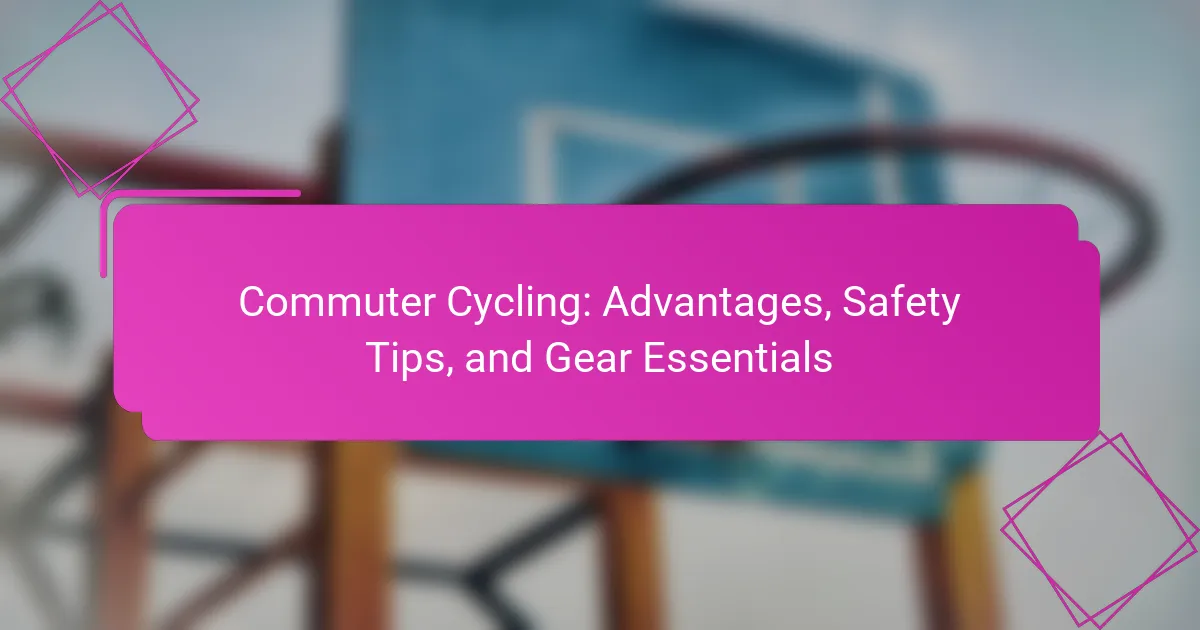Commuter cycling provides significant benefits such as improved health, cost savings, and environmental sustainability. This article covers essential safety tips, necessary gear, and maintenance practices to enhance your cycling experience. Learn how to navigate urban landscapes safely while enjoying the advantages of this eco-friendly transportation option. Access community resources to further support your commuting journey.

What are the key benefits of commuter cycling?
Commuter cycling offers numerous benefits, including improved physical health, reduced transportation costs, and lower environmental impact. It enhances cardiovascular fitness, aids in weight management, and decreases stress levels. Additionally, cycling can save money on fuel and parking while contributing to cleaner air and reduced traffic congestion. Engaging in this activity promotes a sustainable lifestyle and supports mental well-being.
How does cycling improve physical health?
Cycling significantly enhances physical health by improving cardiovascular fitness, building muscle strength, and aiding weight management. Regular cycling increases endurance and reduces the risk of chronic diseases. Studies show that commuting by bike can lead to a 45% lower risk of heart disease. Additionally, it promotes mental well-being, reducing stress and anxiety.
What environmental advantages does cycling offer?
Cycling offers significant environmental advantages, including reduced air pollution and lower greenhouse gas emissions. It decreases reliance on fossil fuels, promotes sustainable urban mobility, and conserves energy. Furthermore, cycling reduces traffic congestion, leading to less idling and emissions from vehicles. As a result, cities with higher cycling rates often experience improved air quality and a healthier environment.
How does commuting by bike save money?
Commuting by bike saves money primarily through reduced transportation costs. Cyclists avoid expenses like fuel, parking fees, and public transit fares. Additionally, maintenance costs for bikes are generally lower than those for cars. A study found that cycling can save commuters over $1,000 annually compared to driving.
Why is cycling beneficial for mental health?
Cycling significantly boosts mental health by reducing stress and anxiety. Engaging in regular commuter cycling promotes the release of endorphins, enhancing mood. Studies show that physical activity, such as cycling, can alleviate symptoms of depression and improve overall mental well-being. Additionally, cycling fosters social connections and provides a sense of accomplishment, further contributing to positive mental health outcomes.

What safety measures should cyclists take?
Cyclists should wear helmets, use lights, follow traffic rules, and remain visible to ensure safety. Additionally, maintaining a safe distance from vehicles and using designated bike lanes can significantly reduce the risk of accidents. Regularly checking the bike’s condition and signaling turns enhances overall safety.
Which protective gear is essential for safe cycling?
Essential protective gear for safe cycling includes a helmet, reflective clothing, gloves, and lights. A helmet protects the head, while reflective clothing enhances visibility. Gloves improve grip and comfort, and lights ensure safety during low-light conditions.
How can cyclists enhance their visibility on the road?
Cyclists can enhance their visibility on the road by using reflective gear, lights, and bright colours. Wearing fluorescent or reflective clothing increases visibility during the day and night. Front and rear lights are essential for alerting drivers, especially in low-light conditions. Additionally, using reflective stickers on helmets and bikes further improves safety.
What are the best practices for navigating traffic?
To navigate traffic effectively while commuting by bicycle, prioritise safety and awareness. Maintain a safe distance from vehicles, signal your intentions, and use bike lanes whenever available.
1. Wear a helmet for protection.
2. Use lights and reflectors for visibility.
3. Follow traffic signals and rules.
4. Stay alert to surroundings and pedestrians.
5. Avoid distractions, such as mobile devices.
These practices enhance safety and improve the overall commuting experience.
How can cyclists prepare for adverse weather conditions?
Cyclists can prepare for adverse weather conditions by wearing appropriate gear, adjusting their riding techniques, and planning their routes carefully. Waterproof clothing and shoes help keep dry, while proper bike maintenance ensures safety. Using lights and reflectors enhances visibility in low-light conditions. Additionally, practising defensive riding techniques helps navigate slippery or hazardous surfaces effectively.

What gear is essential for commuter cyclists?
Essential gear for commuter cyclists includes a reliable bike, helmet, lights, lock, and weather-appropriate clothing. A sturdy bike ensures durability and comfort, while a helmet protects against head injuries. Lights enhance visibility in low light conditions. A lock secures the bike against theft, and appropriate clothing ensures comfort in varying weather. Investing in quality gear enhances safety and overall commuting experience.
Which types of bicycles are best suited for commuting?
Hybrid, road, and electric bicycles are best suited for commuting due to their efficiency and comfort. Hybrid bicycles combine features of both road and mountain bikes, offering versatility for various terrains. Road bikes are lightweight and fast, ideal for longer distances on paved roads. Electric bicycles provide assistance, making commutes easier, especially in hilly areas. Each type caters to different commuting needs and preferences, ensuring an optimal cycling experience.
What accessories enhance the commuting experience?
Accessories that enhance the commuting experience include safety gear, convenience items, and comfort enhancements. Essential accessories are helmets, lights, locks, and reflective clothing. These items improve safety by increasing visibility and security. Additionally, a comfortable saddle, handlebar grips, and a weatherproof bag can significantly enhance the riding experience.
How do different climates influence gear choices?
Different climates significantly influence gear choices for commuter cycling. In warmer climates, lightweight and breathable fabrics are essential, while colder climates require insulated and waterproof gear.
| Climate Type | Gear Essentials | Unique Attribute |
|————–|—————–|——————|
| Warm | Breathable jerseys, lightweight shorts | Moisture-wicking technology |
| Cold | Insulated jackets, thermal tights | Windproof materials |
| Rainy | Waterproof jackets, fenders | High visibility features |
| Humid | Ventilated helmets, quick-dry fabrics | Antimicrobial properties |
| Mountainous | Sturdy shoes, durable outerwear | Enhanced grip soles |
What are the must-have tools for bike maintenance?
Essential tools for bike maintenance include a multi-tool, tyre levers, a pump, and a chain cleaner. These tools ensure your bike remains in optimal condition for commuting. A multi-tool provides various functions, allowing adjustments on-the-go. Tyre levers help with flat repairs, while a reliable pump maintains tyre pressure. A chain cleaner keeps the drivetrain efficient, enhancing overall performance.

How can cyclists maintain their bikes effectively?
Cyclists can maintain their bikes effectively by following regular maintenance routines. Check tyre pressure weekly and inspect tyres for wear. Clean and lubricate the chain every month to ensure smooth operation. Adjust brake and gear systems as needed for optimal performance. Store the bike in a dry place to prevent rust and damage. Regularly check bolts and components for tightness to avoid accidents.
Which routine checks should every cyclist perform?
Every cyclist should perform routine checks on their bike to ensure safety and efficiency. Key checks include inspecting tyre pressure, brake functionality, chain lubrication, and gear shifting. Regular maintenance promotes a smoother ride and reduces the risk of accidents.
1. Check tyre pressure: Ensure tyres are inflated to the recommended PSI.
2. Inspect brakes: Test both front and rear brakes for responsiveness.
3. Lubricate chain: Apply appropriate lubricant to keep the chain running smoothly.
4. Test gears: Shift through all gears to confirm smooth transitions.
5. Examine lights: Ensure front and rear lights are functioning for visibility.
6. Inspect frame: Look for any cracks or damage that could affect safety.
What are common maintenance mistakes to avoid?
Common maintenance mistakes to avoid include neglecting tyre pressure, skipping regular cleaning, ignoring brake adjustments, and failing to lubricate the chain. These oversights can compromise safety and performance.
1. Neglecting tyre pressure: Low pressure increases rolling resistance and can lead to flats.
2. Skipping regular cleaning: Dirt buildup can damage components and reduce lifespan.
3. Ignoring brake adjustments: Poor brakes can result in accidents.
4. Failing to lubricate the chain: A dry chain wears out faster and affects shifting.
How can cyclists extend the lifespan of their bikes?
Regular maintenance and proper care can significantly extend a bike’s lifespan. Here are key practices for cyclists to consider:
1. Clean the bike regularly to remove dirt and grime.
2. Lubricate the chain and moving parts to reduce wear.
3. Check tyre pressure and tread regularly to ensure safety and performance.
4. Inspect brakes and gears for proper functionality.
5. Store the bike in a dry, sheltered location to prevent rust and damage.
6. Schedule professional tune-ups at least once a year for comprehensive checks.
Implementing these practices can enhance durability and performance, ensuring a better commuting experience.

What community resources support commuter cyclists?
Community resources supporting commuter cyclists include local bike shops, cycling advocacy groups, and city-sponsored bike programs. These resources often provide maintenance services, safety workshops, and route planning assistance. For instance, many cities have established bike lanes and public bike-sharing systems to enhance safety and convenience. Additionally, community events promote cycling culture and connect cyclists with one another. Accessing these resources can significantly improve the commuting experience for cyclists.
Which local organizations promote cycling safety?
Local organizations that promote cycling safety include advocacy groups, community programs, and government initiatives. These entities focus on education, infrastructure improvements, and awareness campaigns. For example, the League of American Bicyclists offers resources and training for safe cycling practices. Additionally, local bike clubs often host safety workshops and group rides to foster safe cycling habits. Community events, like bike-to-work days, further encourage safe cycling through engagement and support.
How can cyclists connect with others in their area?
Cyclists can connect with others in their area through local cycling clubs, social media groups, and community events. Joining a cycling club provides structured rides and social opportunities. Utilizing platforms like Facebook or Meetup helps find local cycling enthusiasts. Participating in community events, such as charity rides or cycling festivals, fosters connections and promotes a sense of community among cyclists.
What events and initiatives encourage cycling?
Events and initiatives that encourage cycling include community rides, bike-to-work days, and cycling festivals. These activities promote awareness, provide social interaction, and foster a cycling culture. Local governments often support these initiatives through infrastructure improvements and safety campaigns. Engaging events can increase participation and highlight cycling’s health benefits.

What expert tips can enhance the commuter cycling experience?
To enhance the commuter cycling experience, prioritise safety, comfort, and efficiency.
1. Invest in quality gear, including a well-fitted helmet, reflective clothing, and lights for visibility.
2. Maintain your bicycle regularly to ensure smooth rides and prevent breakdowns.
3. Plan your route to avoid busy roads and increase safety, using bike lanes when available.
4. Stay aware of your surroundings and anticipate the actions of drivers and pedestrians.
5. Hydrate and take breaks as needed to maintain energy and focus during your commute.
How can cyclists optimize their routes for efficiency?
Cyclists can optimize their routes for efficiency by using navigation apps, planning ahead, and considering traffic patterns. These tools help identify the fastest paths, avoiding congested areas. Incorporating bike lanes and shortcuts increases travel speed. Regularly analyzing route performance can lead to continuous improvements.
What strategies help in building a cycling routine?
Establishing a cycling routine involves consistency, planning, and motivation. Start by setting specific goals like distance or frequency. Incorporate cycling into your daily commute to build habit. Schedule rides at convenient times to enhance adherence. Track progress using apps or journals to stay motivated. Join cycling groups for social support and accountability.
How can technology improve the commuting experience?
Technology can significantly enhance the commuting experience for cyclists. Smart bike locks, GPS navigation, and cycling apps improve safety and convenience.
Smart bike locks offer keyless entry and tracking features, reducing theft risk. GPS navigation provides real-time traffic updates, helping cyclists choose safer routes. Cycling apps track performance metrics and offer community support, motivating users to ride more.
Additionally, electric bicycles have gained popularity, providing assistance on longer commutes. Smart helmets with integrated lights and communication systems further enhance safety.
As urban areas invest in cycling infrastructure, technology continues to play a crucial role in making commuting by bike more appealing and efficient.
